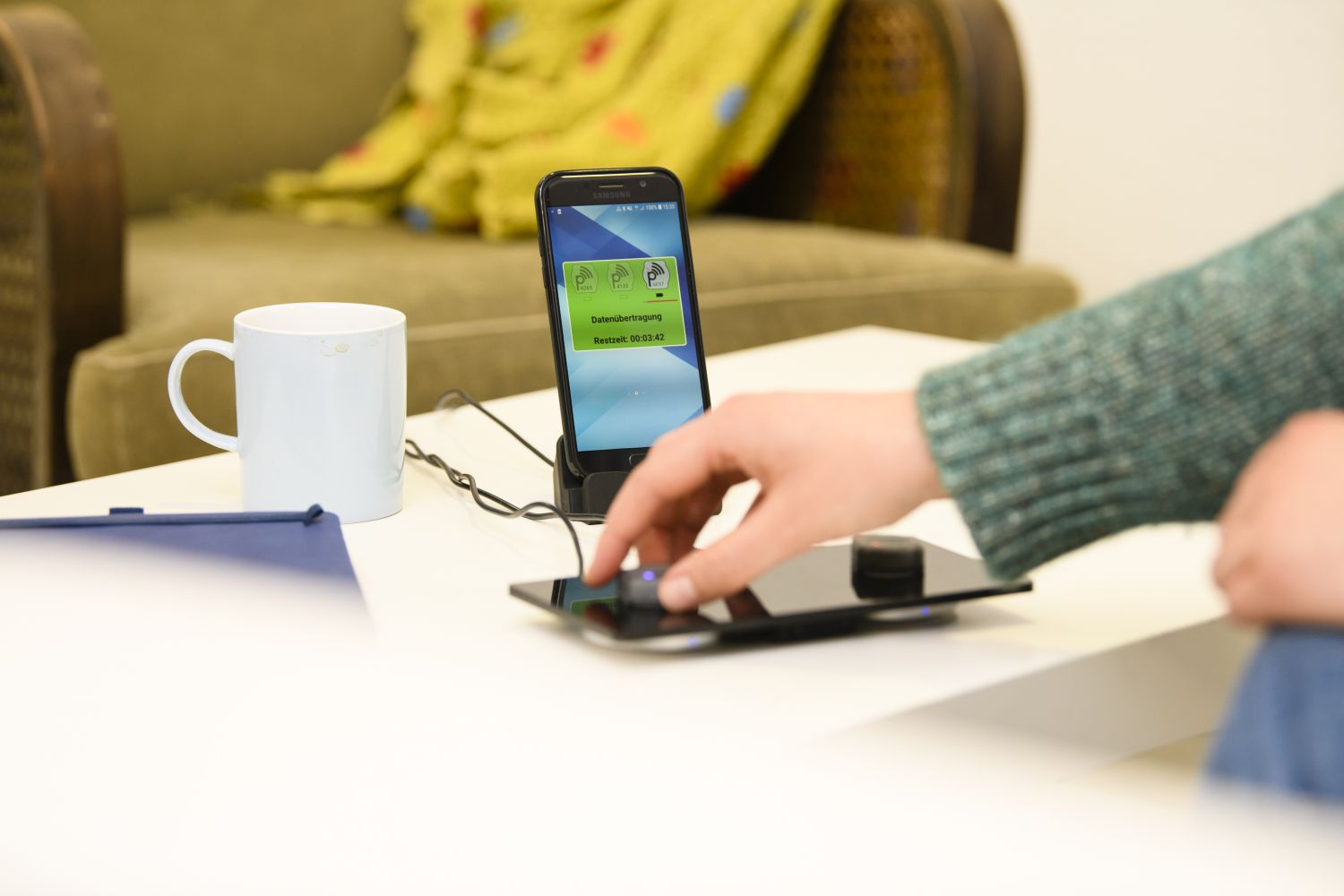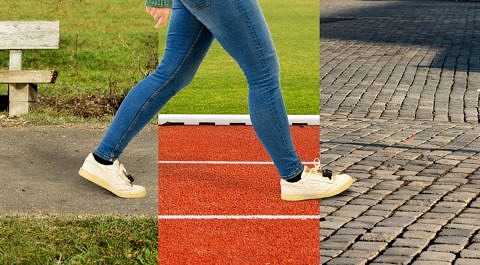One step at a time
Neurologists and computer scientists at FAU have designed a shoe which monitors the movements of Parkinson’s patients and uses artificial intelligence to allow for more objective diagnosis and treatment. It is hoped that the system will bring about a lasting improvement to the mobility and quality of life of those suffering from neurological disorders.
Running, jumping, climbing, swimming, cycling or even just going for a walk: our quality of life depends to a great extent on our ability to move without impediment. Sadly, we often only really appreciate this once our ability is restricted in some way, perhaps by neurological diseases such as stroke, multiple sclerosis or Parkinson’s, as a result of inflammation in our joints or muscles or due to tumours. Mental health conditions such as depression or dementia can also affect mobility.
For all of these disorders, there are diagnostic parameters which are used to determine the severity and stage of the disease and decide when to start appropriate treatment. The problem, however, is that clinical diagnostics does not take sufficient account of patients’ day to day lives and mental state. ‘We can measure blood pressure and reflexes, check muscle tone or evaluate ECG readings,’ explains Prof. Dr. Jochen Klucken. ‘However, these are only of secondary importance for the patient. At the end of the day, what concerns them most is to what extent their daily life will be restricted. For the medical profession, which generally tends to take a more scientific approach, this is much less important.’
Traditional diagnostics too ‘general and subjective’
Klucken is a senior physician and deputy head of the Department of Molecular Neurology at Universitätsklinikum Erlangen. His research focuses on the impact neurological diseases have on bodily functions, including mobility. The mobility of Parkinson’s patients, for example, gets progressively worse. At first, they experience a general slowness of movement and difficulties coordinating muscles, which has a detrimental effect on facial expressions, speech, swallowing and dexterity. Later, they may develop an incorrect posture and experience rigidity, a slow tremor or reduced stability and problems with walking and balance.
Symptoms like these are examined and classified by the patient’s doctor. The Unified Parkinson’s Disease Rating Scale is the international standard used in clinical studies. In order to assess the stage to which the disease has progressed, doctors check mental functions for an indication of impaired thought processes or depression, analyse general activities of daily living such as writing, getting dressed and hygiene, and observe motor skills such as language, hand movements and gait. Each of these symptoms is allocated a score from zero to four, with zero representing no disability and four representing total disability. ‘Assessing symptoms in this way was developed for use in clinical studies,’ says Jochen Klucken. ‘A score is calculated and then used to indicate the differences between groups of patients being given different treatments.’

However, Dr. Klucken believes that categorising patients on the basis of their symptoms in this way is not the best solution, as it only paints a very ‘approximate and subjective’ picture. It is of little to no benefit when deciding which treatment should be chosen for which individual, assessing the effectiveness of treatment or working out which dosage of medication should be given. ‘From a medical point of view, there is little difference between a score of one or two,’ he says. ‘For patients, they may be worlds apart.’ Relying on instruments such as ECG, EEG, or MRI scans to make a diagnosis is also difficult, as they cannot be used to assess dynamic movements. In addition, doctors can only carry out a spot check at one particular time, and the results will always depend on how the patient is feeling on that particular day, under the current circumstances and on their current dose of medication. Klucken believes it would make more sense to observe the patient over a longer period of time, for example in special movement laboratories. However, facilities such as this are extremely rare in clinical practice and they certainly cannot be set up directly in the patient’s home.
FAU team designs shoe with integrated sensors for Parkinson’s patients
How else can we accurately reproduce the patient’s daily circumstances and objectively assess the progression of the disease? Researchers experienced a light-bulb moment when an invention which was initially designed for the fitness and lifestyle market rather than medical practice came on the market: wearables. These are wristbands or watches which measure the wearer’s pulse and step frequency to give feedback on their physical activity. ‘We wanted to take the principle of using sensors to record movement and use it for neurological diagnostic purposes,’ explains Jochen Klucken. ‘We hoped to come up with a solution which is not only able to measure the relevant parameters, but also sturdy, simple and reasonably priced. It should make straightforward monitoring possible both in hospitals and in the patient’s own home.’
The ‘Mobile GaitLab’ has brought the researchers much closer to attaining their goal. At the heart of the solution, which researchers have been working on for 12 years now, is a shoe fitted with a sensor that measures various gait parameters for each patient: speed, pace length, regularity and how high the foot is lifted. Even the smallest change can be an indication of a deterioration, or more positively, improvement to the progression of the disease. The sensor itself is not much different from those used to detect the spatial location of smartphones, ensuring that the screen rotates automatically. It was confirmed during a test phase lasting several years and involving numerous clinical studies that the recorded gait parameters correlate very well with the symptoms of the disease. The shoe with integrated sensor was certified as a medical product several months ago and can be used for daily care purposes.
Artificial intelligence supports gait Analysis
Accurate sensors and recorded data alone won’t get you far, however. This is why the neurologists have joined forces with Prof. Dr. Björn Eskofier from the Chair of Machine Learning and Data Analysis. Eskofier is an expert in pattern recognition using artificial intelligence, which is used for example in assessing image data, but also for processing the almost 700 individual measurements delivered by the sensor integrated in the shoe. ‘An individual’s gait is as unique as their fingerprint,’ Eskofier explains. ‘We need self-learning algorithms which both understand the pattern of the individual’s unique gait and are able to assess any changes.’ This assessment also involves analysing contextual factors, Eskofier continues. ‘What does it mean, for example, if the patient is walking particularly slowly? Has his condition deteriorated or is he out for a walk with his elderly mother? The more data we can collect and interpret meaningfully, the better the system will work.’

The greatest strength of the Mobile GaitLab is its ability to generate objective scores from the raw data, which can then be used to decide on a suitable course of treatment. ‘For this to be effective, however, doctors’ surgeries, clinics and therapists would need a digital network which is able to process the data which are transferred online,’ says Jochen Klucken. ‘Unfortunately, we are still years away from a set-up like that.’ However, it is hoped that the shoe with the integrated sensor will also be able to help patients directly, for example allowing them to adjust their medication dosage independently. That could increase quality of life in several different ways, for example by easing acute symptoms of the disease, and by reducing the number of visits to a doctor. This is an area where digital health applications may be beneficial, in other words the ‘app on prescription’ provided for in the new digital healthcare act.
‘There are still a lot of open issues, such as how to deal with the collected data, how long they can be stored and who can access them,’ says Klucken. ‘However, I am convinced that the shoe with the integrated sensor will make a contribution towards improving the mobility of patients in the long-term, not only for Parkinson’s, but also for multiple sclerosis or stroke.’
About the author
Matthias Münch studied sociology before working as a freelance journalist for several daily newspapers. Since 2001, he has been providing support for companies and academic institutions in the areas of PR and corporate communication.
FAU research magazine friedrich
 This article first appeared in our research magazine friedrich. You can order the print issue (only available in German) free of charge at presse@fau.de.
This article first appeared in our research magazine friedrich. You can order the print issue (only available in German) free of charge at presse@fau.de.
